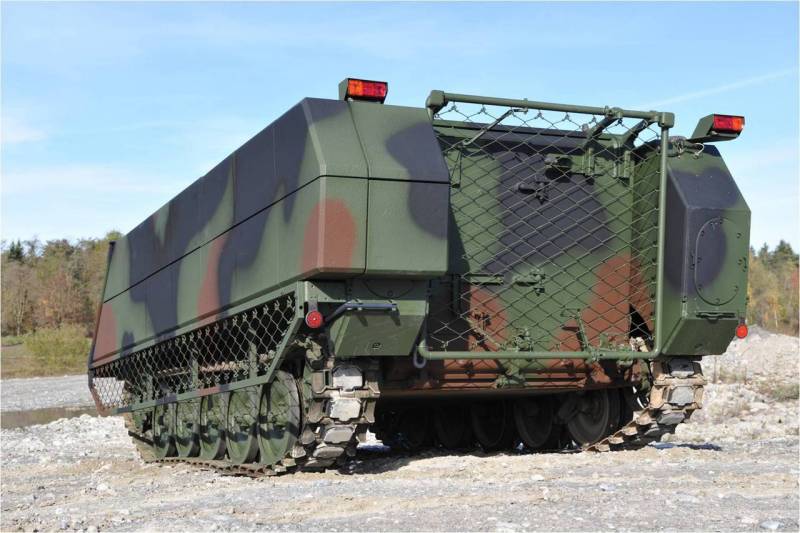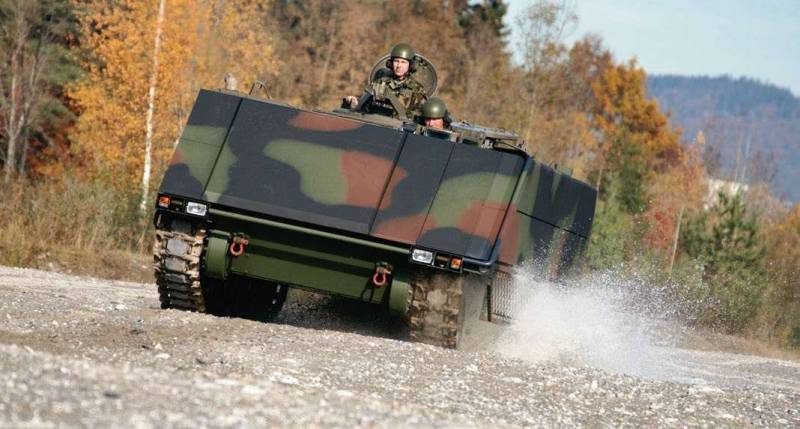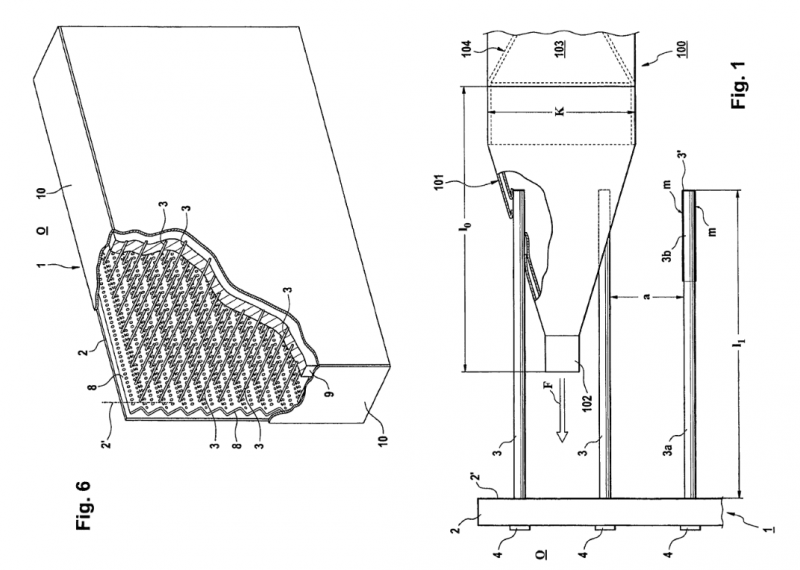Additional Protection System RUAG SidePRO-RPG (Switzerland)
Over the past few decades, the Swiss designers from RUAG Defense have been working to create additional defenses for armored vehicles of various classes, which help prevent anti-tank ammunition. The main result of these works was the emergence of a line of projects with the common name SidePRO. It includes mounted blocks of additional protection, mesh or lattice screens and other products designed to counteract cumulative ammunition. Several systems of additional protection of a different kind were also created. SidePRO-RPG mounted blocks have become the most difficult representative of their family.
The task of the RUAG SidePRO-RPG project was to create a relatively easy and simple system suitable for installation on existing combat armored vehicles and providing effective protection against common types of anti-tank weapons. Armed with many armies of the world and armed formations are RPG-7 hand grenade launchers, and this was taken into account when developing a new project. In fact, the SidePRO-RPG system was developed to protect it from PG-7В grenades and their modifications.
The hinged blocks of the SidePRO-RPG system have an extremely simple appearance. For installation on armored vehicles, box-shaped devices with metal housings with the lowest possible mass are offered. The shape and configuration of the blocks depend on the features of the future carrier. Blocks can have both straight and beveled edges - taking into account the installation location of the product. All units designed for installation on any parts of the body of armored vehicles, have a thickness of 250 mm.
The exterior features of the base combat vehicle determine only the shape and configuration of the body of the additional protection unit, while its internal equipment is the same in all cases. The body is proposed to be made of a relatively thin metal, which does not provide full protection even for bullets or fragments. Thus, the SidePRO-RPG product, originally intended to counter cumulative ammunition, does not increase the level of ballistic protection. The effect of a spaced booking, formed by the car’s own body and the metal of the hinged module, is not created.
At the bottom of the module case, it is proposed to install a perforated sheet of armor having a corrugated shape. Holes in this part are designed for mounting other devices, and to reduce weight. A significant part of the holes of the corrugated sheet is intended for the installation of metal pins. In accordance with the idea of engineers RUAG Defense, the main means of countering cumulative ammunition are metal rods with a diameter of several millimeters mounted parallel to the calculated trajectory of the flying anti-tank grenade. The distance between the rods does not exceed several centimeters and is determined taking into account the dimensions of PG-7В products and the like.
The free upper ends of the bars, resting against the lid of the metal case, are additionally covered with a polymer screen. Apparently, it is necessary to hold the damaging elements in the desired position, and also to some extent complements other elements of the structure and thereby increases part of the protection characteristics.
The rather simple design gives SidePRO-RPG blocks certain advantages over the additional protection modules of other models. First of all, the Swiss development system is small in size and weight. The thickness of the blocks does not exceed 250 mm. The mass of the product of earlier versions is no more than 45 kg per square meter. Thus, in terms of mass, the mounted units correspond to steel armor plates with a thickness of no more than 6 mm. At the same time, SidePRO-RPG modules differ from steel screens by an incomparably high level of protection against anti-tank weapons.
The RUAG SidePRO-RPG additional protection system has a very simple principle of operation and is not difficult to operate. A relatively thin module case cannot protect the armored vehicle from firing from small arms weapons or from artillery shell fragments. At the same time, bullets and fragments piercing the body of the hinged unit do not cause serious damage to its internal equipment, which allows it to maintain the required capabilities and characteristics.
A PG-7B anti-tank rocket grenade or similar ammunition, once in the SidePRO-RPG module, easily breaks through its outer case and polymer inner sheet. Having punched a light body, the head part of the grenade literally punctures internal metal rods, the dimensions and placement of which correspond to its geometry. Damage to the head of the grenade caused by pins, prevent its proper operation. Breaking the elements of the fuse does not allow the grenade to be blown up, and damage to the charge drastically reduces armor penetration, or completely eliminates the formation of a cumulative jet.
Corrugated armor plate with attachments for rods is designed to absorb the impact pulse, or to take over part of the shock wave of the explosion. Possible fragments and the remaining force of the shock wave at the same time must stop with their own armor of the combat vehicle carrier.
The RUAG SidePRO-RPG additional protection complex was initially designed to counter shots of the RPG-7 hand-held grenade launcher and its copies. Such weapons have long been widespread, and also represents a particular danger to light armored vehicles. The strength characteristics and placement of internal rods were determined taking into account the parameters of grenades PG-7В, PG-7ВМ, PG-7ВЛ, etc. It can be assumed that mounted modules are able to show themselves well when other anti-tank weapons with similar ammunition are used by the enemy.
Despite the simplicity of its design, the Swiss additional protection system has a rather high performance. According to RUAG Defense, blocks with internal rods prevent the cumulative grenades from firing correctly in more than 80% cases. In other words, four out of five grenades, once in such a module, are destroyed or undermined in an irregular manner. Only 20% are completed with the correct disruption and the formation of a cumulative jet that threatens the armored vehicle.
By its effectiveness, the SidePRO-RPG system is comparable to modern models of dynamic protection complexes, however, it is favorably distinguished by its smaller mass and ease of adaptation to specific models of armored vehicles. With the proper design of a set of modules, you can close all the external surfaces of the combat vehicle without leaving bare spaces, as is sometimes the case with dynamic protection.
The first version of the complex was developed in the middle of the last decade, and soon it was offered to potential buyers. To demonstrate the capabilities of the original design, sets of mounted modules were prepared for specific types of equipment. The promotional materials for the SidePRO lineup featured tracked armored personnel carrier M113 of American design and the French wheeled combat vehicle VBCI. These samples initially had only anti-bullet armor, and the installation of SidePRO-RPG units made it possible to significantly increase their survivability.
Together with the box-shaped modules for additional protection, prototypes received some other means from RUAG Defense. The running gear, stern doors and other elements of the equipment were additionally covered with sidePet latticed or mesh screens. Thus, a pair of prototypes could clearly demonstrate an integrated approach to enhancing protection against anti-tank weapons.
For one reason or another, the basic version of RUAG SidePRO-RPG could not be the subject of a contract. However, the development company continued the development of existing ideas, and soon introduced a new modification of additional protection. With the help of various improvements and improvements, the weight of the modules was reduced by one and a half times. In the 2012 version of the year, a square meter of protection weighs only 30 kg — many times less than dynamic protection with similar parameters.
In 2013, the first reports of an export contract for promising additional reservation modules appeared. Who exactly wished to purchase such products, however, was not noted. Subsequently, several more similar News. A number of foreign armies also showed interest in complexes of the SidePRO family, and in some cases negotiations even reached the signing of the contract. However, the original Swiss complex did not become truly massive and widespread.
However, despite the very limited commercial success, RUAG Defense continues to advertise its latest developments, including the SidePRO-RPG modules. It is quite possible that in the foreseeable future, it will introduce another improved version of this system, and new contracts will follow. The market for additional protection for light armored vehicles is constantly growing, and all developers of such systems have certain chances to get their share of orders.
Like other means of additional protection, the RUAG SidePRO-RPG complex has pros, cons, and ambiguous features. The latter can be attributed to the specialization of this system. The design of mounted modules is such that it provides protection only against cumulative ammunition. In theory, they can be used with ballistic protection units, but this can lead to new technical problems. The fact is that the unit with internal rods must be placed outside: the anti-tank grenade must be able to pierce the light module case. Otherwise, it will not be damaged and will explode in a regular manner.
The absolute plus of the proposed system is compactness and lightness. The thickness of the modules does not exceed 250 mm, and the mass of a square meter, depending on the modification, is 45 or 30 kg. Due to this, the dimensions of the armored vehicle vary within acceptable limits, and the weight increases slightly. A complete set of mounted units for the average modern armored personnel carrier will weigh only a few quintals - at times less than the dynamic protection with similar parameters.
The claimed effectiveness exceeding 80% is also a plus of the SidePRO-RPG system. As already mentioned, in this parameter, the lightened protection complex hardly differs from the representatives of other classes. Under certain circumstances, SidePRO-RPG blocks may be supplemented by other systems in their family. Thus, the sides of an armored vehicle can be equipped with anti-cumulative protection modules, while the undercarriage and other elements of technology can be covered with SidePRO-Lasso nets.

M113 with extra protection. Most of the hull is equipped with SidePRO-RPG products, the chassis and aft ramp are equipped with SidePRO-Lasso nets
The Swiss product differs from other means of additional protection by higher maintainability. When a grenade is destroyed without an explosion, the unit retains its efficiency. He may need to extract the remnants of a grenade and install a new cover, but is still able to withstand the next hit. Destruction of a set of pins is also not a big problem. In this case, you can replace the entire module, and then, if possible, change the damaged parts.
However, the complex is not without serious flaws. Its main disadvantage is the limited potential in terms of the nomenclature of "compatible" anti-tank ammunition. Swiss designers took into account the parameters of the shots for RPG-7 grenade launchers, LNG-9, etc., but did not take into account the features of more advanced weapons. The grenade launchers which appeared later differ in a different geometry of the ammunition. Thus, the results of the interaction of the warhead with a set of rods may differ markedly with clear results for the level of protection. For example, a situation is possible in which the grenade will have time to hit the bottom of the module case before it receives critical damage from the rods. The result will be the undermining and penetration of the main body.
We should also recall the more serious threats. Many modern anti-tank systems are equipped with ammunition with a tandem cumulative warhead. Whether SidePRO-RPG can withstand such a shot is unknown. Available information suggests that a set of rods can actually destroy two charges without an explosion. At the same time, however, undermining the leading charge and the destruction of the elements of protection will allow the main one to easily reach the goal.
In general, the RUAG SidePRO-RPG supplementary protection system provides a convenient means of increasing the resistance of light armored vehicles to cumulative ammunition and improving overall survivability on the battlefield. It has certain limitations and cannot fight all real or potential threats, but at the same time it reduces in the most noticeable way the likelihood of destruction of equipment that initially had no protection against PG-7В grenades or similar ammunition. Thus, both independently and in combination with other samples, this system may be of some interest to potential customers.
Having entered the international market, RUAG SidePRO family systems, including the SidePRO-RPG, managed to become the subject of several export contracts. However, the number of such contracts is not too large, and potential buyers do not show the expected interest. Perhaps in the future the situation will change in one way or another, and the original Swiss developments will still be able to get a noticeable spread. However, the saturation of the market can lead to the opposite result, leaving the SidePRO-RPG on the existing positions.
On the materials of the sites:
https://ruag.com/
http://btvt.narod.ru/
http://army-guide.com/
https://below-the-turret-ring.blogspot.fr/
https://strangernn.livejournal.com/
- Ryabov Kirill
- RUAG Defense / ruag.com


Information